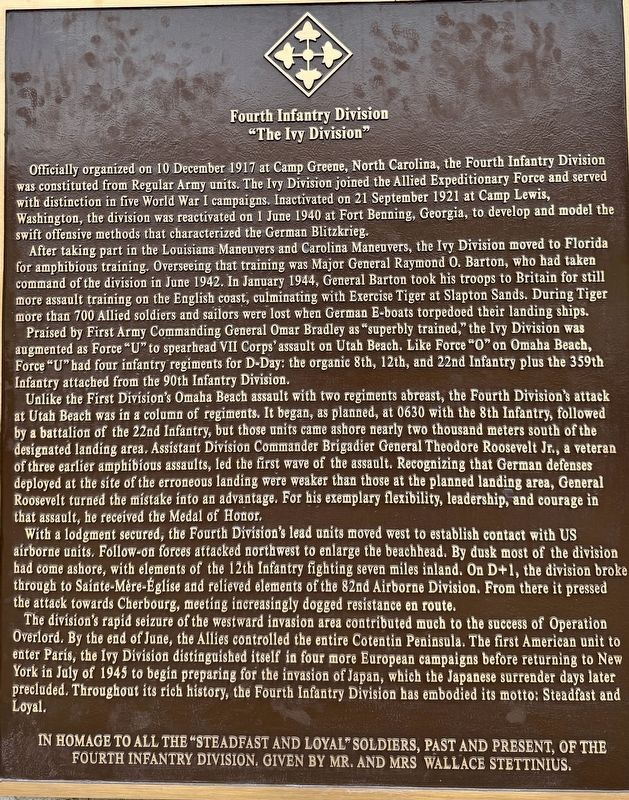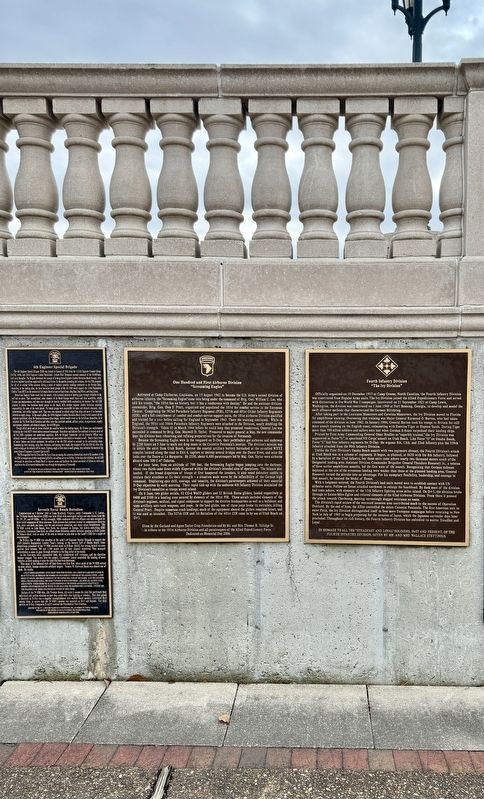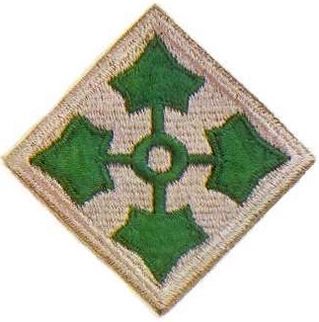Bedford in Bedford County, Virginia — The American South (Mid-Atlantic)
Fourth Infantry Division
“The Ivy Division”
— National D-Day Memorial —
After taking part in the Louisiana Maneuvers and Carolina Maneuvers, the Ivy Division moved to Florida for amphibious training. Overseeing that training was Major General Raymond O. Barton, who had taken command of the division in June 1942. In January 1944, General Barton took his troops to Britain for still more assault training on the English coast, culminating with Exercise Tiger at Slapton Sands. During Tiger more than 700 Allied soldiers and sailors were lost when German E-boats torpedoed their landing ships. Praised by First Army Commanding General Omar Bradley as "superbly trained," the Ivy Division was augmented as Force "U" to spearhead VII Corps' assault on Utah Beach. Like Force "O" on Omaha Beach, Force "U" had four infantry regiments for D-Day: the organic 8th, 12th, and 22nd Infantry plus the 359th Infantry attached from the 90th Infantry Division.
Unlike the First Division's Omaha Beach assault with two regiments abreast, the Fourth Division's attack at Utah Beach was in a column of regiments. It began, as planned, at 0630 with the 8th Infantry, followed by a battalion of the 22nd Infantry, but those units came ashore nearly two thousand meters south of the designated landing area. Assistant Division Commander Brigadier General Theodore Roosevelt Jr., a veteran of three earlier amphibious assaults, led the first wave of the assault. Recognizing that German defenses deployed at the site of the erroneous landing were weaker than those at the planned landing area, General Roosevelt turned the mistake into an advantage. For his exemplary flexibility, leadership, and courage in that assault, he received the Medal of Honor.
With a lodgment secured, the Fourth Division's lead units moved west to establish contact with US airborne units. Follow-on forces attacked northwest to enlarge the beachhead. By dusk most of the division had come ashore, with elements of the 12th Infantry fighting seven miles inland. On D+1, the division broke through to Sainte-Mère-Église and relieved elements of the 82nd Airborne Division. From there it pressed the attack towards Cherbourg, meeting increasingly dogged resistance en route.
The division's rapid seizure of the westward invasion area contributed much to the success of Operation Overlord. By the end of June, the Allies controlled the entire Cotentin Peninsula. The first American unit to enter Paris, the Ivy Division distinguished itself in four more European campaigns before returning to New York in July of 1945 to begin preparing for the invasion of Japan, which the Japanese surrender days later precluded. Throughout its rich history, the Fourth Infantry Division has embodied its motto: Steadfast and Loyal.
In homage to all the “Steadfast and loyal “ soldiers, past and present, of the Fourth Infantry Division. Given by Mr. and Mrs. Wallace Stettinius.
Erected by National D-Day Memorial.
Topics and series. This memorial is listed in these topic lists: War, World II • Waterways & Vessels. In addition, it is included in the U.S. National D-Day Memorial series list. A significant historical date for this entry is June 6, 1944.
Location. 37° 19.855′ N, 79° 32.161′ W. Marker is in Bedford, Virginia, in Bedford County. Memorial can be reached from Overlord Circle, 0.4 miles west of Burks Hill Road. The Marker is located on the grounds of the National D-Day Memorial. Touch for map. Marker is at or near this postal address: 3 Overlord Circle, Bedford VA 24523, United States of America. Touch for directions.
Other nearby markers. At least 8 other markers are within walking distance of this marker. One Hundred and First Airborne Division (here, next to this marker); 6th Engineer Special Brigade (here, next to this marker); Seventh Naval Beach Battalion (here, next to this marker); The Eighty Second Airborne Division (here, next to this marker); 1st Engineer Special Brigade (here, next to this marker); Second Naval Beach Battalion (here, next to this marker); 29th Infantry Division (here, next to this marker); Sixth Naval Beach Battalion (here, next to this marker). Touch for a list and map of all markers in Bedford.
Also see . . .
1. 4th Infantry Division- U.S. Army Divisions. (Submitted on February 10, 2024, by Brandon D Cross of Flagler Beach, Florida.)
2. National D-Day Memorial. (Submitted on February 10, 2024, by Brandon D Cross of Flagler Beach, Florida.)
Credits. This page was last revised on February 10, 2024. It was originally submitted on February 10, 2024, by Brandon D Cross of Flagler Beach, Florida. This page has been viewed 49 times since then. Photos: 1, 2, 3. submitted on February 10, 2024, by Brandon D Cross of Flagler Beach, Florida. • Andrew Ruppenstein was the editor who published this page.


